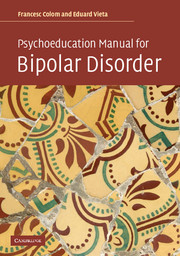Book contents
- Frontmatter
- Contents
- Foreword
- Preface
- Part 1 Clinical, diagnostic, and therapeutic aspects of bipolar disorders
- Introduction
- Bipolar disorders through history
- Diagnosis and classification
- Psychological interventions in bipolar disorders
- Part 2 Concept and methodology of psychoeducation
- Part 3 Psychoeducation program: sessions and contents
- Bibliography
- Index
Bipolar disorders through history
from Part 1 - Clinical, diagnostic, and therapeutic aspects of bipolar disorders
Published online by Cambridge University Press: 06 January 2010
- Frontmatter
- Contents
- Foreword
- Preface
- Part 1 Clinical, diagnostic, and therapeutic aspects of bipolar disorders
- Introduction
- Bipolar disorders through history
- Diagnosis and classification
- Psychological interventions in bipolar disorders
- Part 2 Concept and methodology of psychoeducation
- Part 3 Psychoeducation program: sessions and contents
- Bibliography
- Index
Summary
The first references to mania and melancholia go back to Araeteus of Capadocia in the second century BC. For centuries, the term “mania” was used to refer to agitation syndromes, whatever their origin. The first attempts to find a solid biological substrate for mania arose with the liberalization of cadaver dissection and the advent of the anatomical–clinical methods. However, it was not until the nineteenth century that the concepts of mania and depression were linked conceptually and clinically through the first detailed descriptions of the folie circulaire by Falret and the folie à double forme by Baillarger – both the conditions characterized by states of excitation, sadness, and lucid intervals of variable duration. The introduction of recurrence and the cyclicity to descriptions of the disorder is one of the breakthrough moments in the history of psychiatry, and even discussion of the authorship of the concept makes quite an interesting story (Pichot, 1995). Falret and Baillarger simultaneously, in 1854, described the cyclicity of the disorder. These two doctors worked in the same city (Paris), were of similar age, and were the disciples of a single master, Esquirol, who had actually taught almost all French psychiatrists of the era. They kept up a brisk polemic about who was first to define the concept, each claiming to have described it first, albeit as part of lectures given to young medical students (in the case of Falret) or in a clinical session at the Academy of Medicine (Baillarger).
- Type
- Chapter
- Information
- Psychoeducation Manual for Bipolar Disorder , pp. 4 - 5Publisher: Cambridge University PressPrint publication year: 2006

